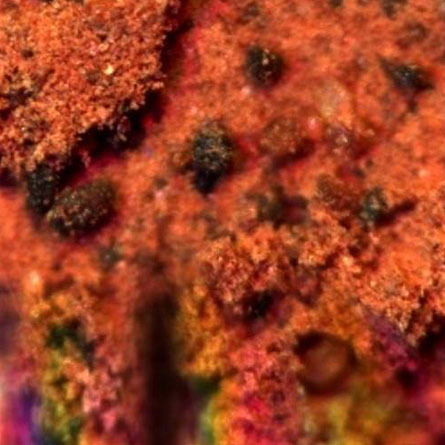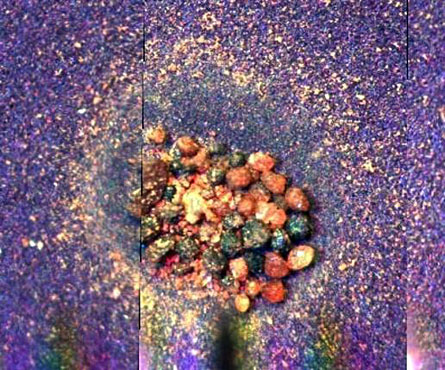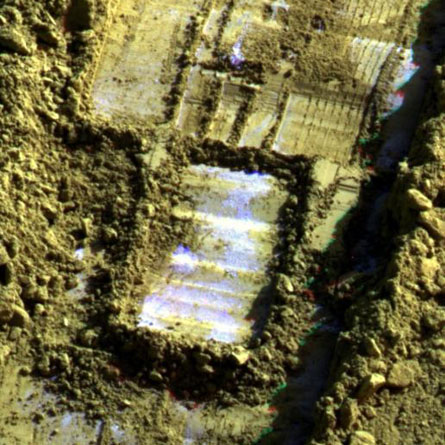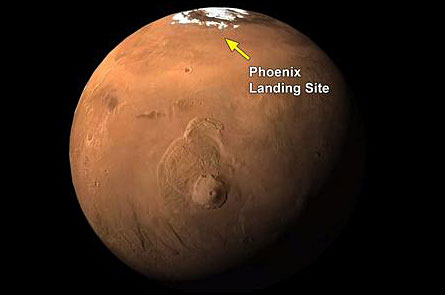Water’s role in Martian chemistry becoming clearer
As mission nears end, Phoenix Mars Lander finds chemical surprises
Perched on a vast plain above the arctic circle of the Red Planet, NASA’s Phoenix Mars Lander has found new evidence that liquid water was once present in the north polar region and interacted with minerals there. Phoenix scientists reported the findings September 29 during a NASA press briefing.




Two Phoenix experiments identified calcium carbonates and clays in soil samples scooped up by the craft’s robotic arm. On Earth, both minerals are associated with the presence of liquid water.
Carbonates such as limestones form on Earth when carbon dioxide from the atmosphere dissolves in liquid water, making carbonic acid. The acid eats away at rocks, which eventually become carbonate deposits such as the White Cliffs of Dover.
An interaction between carbon dioxide and liquid water is “just what we think is going on on the surface of Mars,” says Bill Boynton of the University of Arizona in Tucson. Boynton is lead scientist for Phoenix’s suite of eight miniature ovens and one mass spectrometer collectively known as the Thermal and Evolved-Gas Analyzer, or TEGA.
Spacecraft orbiting the planet have found evidence of carbonates elsewhere on Mars, Boynton notes, but never before in a smooth region devoid of channels, which would suggest the flow of water, he adds.
TEGA’s evidence for calcium carbonates comes from one of its ovens. The robotic arm delivered Martian soil into the ovens, and the high temperature at which carbon dioxide was finally released from the samples matches the temperature at which calcium carbonates decompose.
Phoenix’s wet chemistry experiment, known as the Microscopy, Electrochemistry and Conductivity Analyzer, or MECA, first dissolved a sample of the soil in liquid. It then found that the soil solution had a stable, alkaline pH of 8.3 that could not be easily altered, as if it were being buffered. At the same time, the concentration of calcium measured in the wet chemistry analysis is exactly that expected from a solution, such as Earth’s seawater, in which calcium carbonate stabilizes the pH level.
The two independent measurements, from the ovens and wet experiments, reveal that the detection of calcium carbonate is “unambiguous,” says Boynton. The amount of calcium carbonate in the soil is substantial, between 3 and 8 percent, he says.
Both experiments also reveal clays that are likely to be phyllosilicates, common on Earth. Such clays have sheetlike structures with water interspersed between the layers. The Phoenix scientists determined this based on the high temperatures required to release water vapor from the clay soil samples in a TEGA oven. In addition, an atomic force microscope on the lander has detected smooth, platelike particles that suggest the presence of the clays, said Michael Hecht of NASA’s Jet Propulsion Laboratory in Pasadena, Calif., the lead scientist for MECA.
It remains a puzzle why water may once have been liquid in this cold arctic region. One possibility, says Phoenix principal investigator Peter Smith, also of the University of Arizona, is that the axis about which Mars rotates has wobbled over millions of years. Many other researchers have suggested that, in the past, the polar region of Mars may have tipped over such that it received much more sunlight than today, becoming warm enough that water might have been liquid.
“We’re approaching that hypothesis,” Smith says, but with the “understanding that Mars has many surprises for us and we haven’t finished our investigation.”
The presence of liquid water would have created a climate that was once hospitable for life.
Another finding, previously announced, may relate to the melting of water-ice, he says. Phoenix has discovered perchlorate, an oxidizing agent that not only acts as a possible energy source for bacteria, but is also known to drastically lower the temperature at which water freezes. The presence of even a sprinkling of perchlorate could keep water liquid at temperatures as low as 60 to 70 degrees C, he notes.
With the discovery of calcium carbonate and perchlorate in the soil samples, there is enough new data “to begin rewriting the book of Martian geochemistry,” says Hecht.
In the meantime, winter is about to begin in the arctic region, where Phoenix landed on May 25. Not only is the sun now dipping below the horizon for more than four hours of the Martian day, but the craft must also expend more energy to keep its instruments from freezing. Scientists are racing against the clock to fill TEGA’s remaining four ovens and continue other experiments. The craft is not expected to survive past November.







